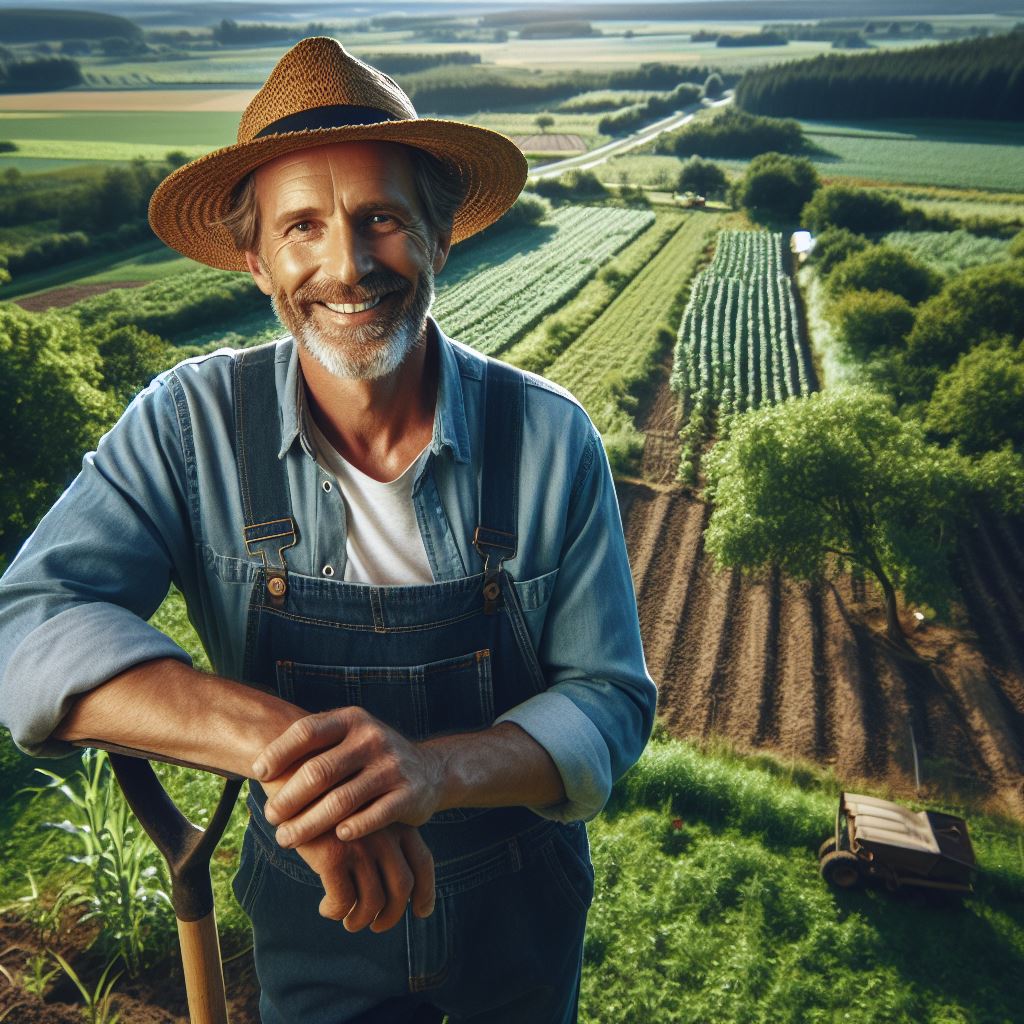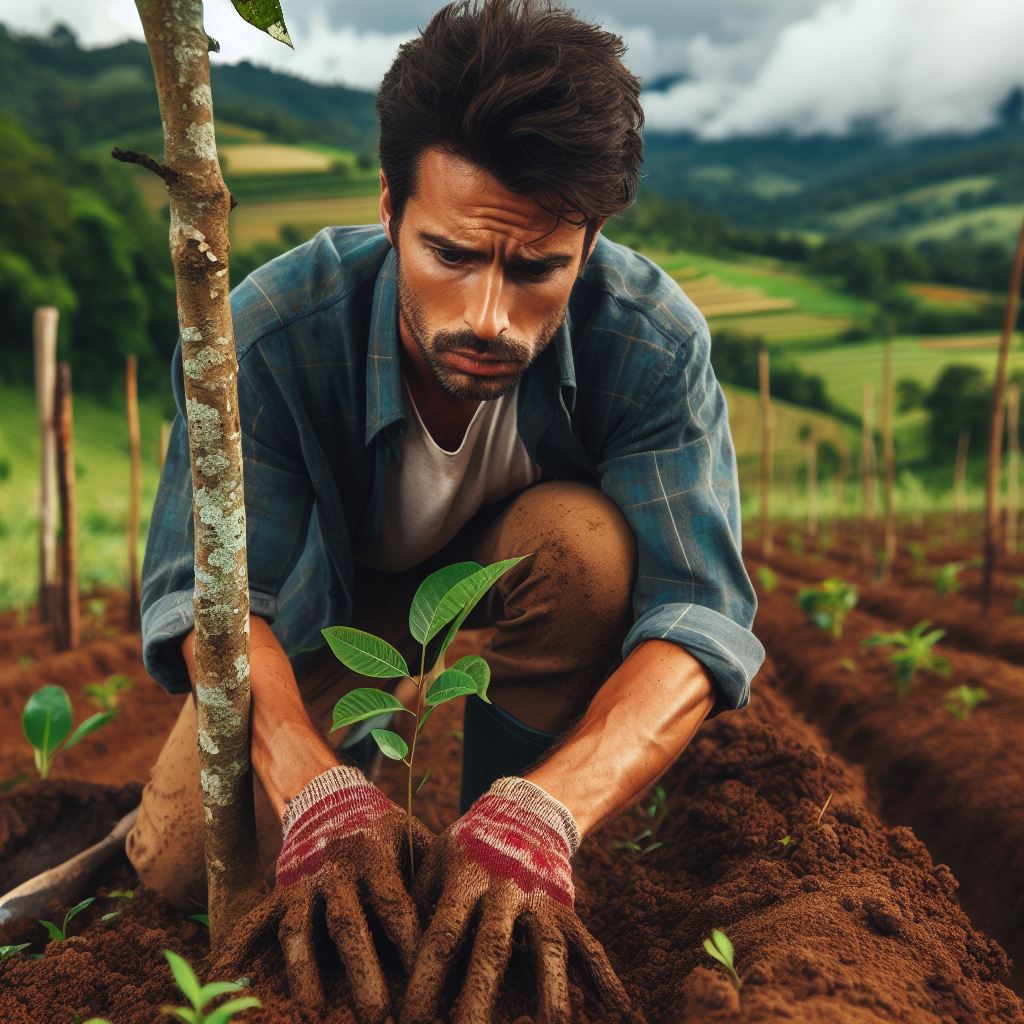Introduction
Agroforestry is the practice of integrating trees, crops, and livestock on the same land.
It combines agriculture and forestry techniques to optimize sustainable land use.
Sustainable land use is vital in agriculture as it ensures long-term productivity, conservation of resources, and environmental protection.
It is crucial for achieving food security and reducing the negative impact of farming activities on the environment.
Agroforestry offers a promising solution to address these challenges by promoting biodiversity, soil fertility, and natural resource conservation.
By incorporating trees into agricultural systems, farmers can enhance crop yields, provide shade and windbreaks, and diversify their income streams.
The integration of trees in agroforestry systems helps in soil retention, erosion control, and water conservation.
Trees act as biological pumps by drawing water from deep soil layers, preventing waterlogging, and improving the water table.
Additionally, they help in nutrient cycling and reducing nutrient runoff, improving soil health and reducing the need for synthetic fertilizers.
Agroforestry also contributes to climate change mitigation and adaptation.
The presence of trees sequesters carbon dioxide from the atmosphere, mitigating greenhouse gas emissions.
It provides microclimatic benefits by reducing temperature extremes, controlling winds, and trapping moisture.
Furthermore, agroforestry systems create habitats for beneficial organisms, such as pollinators and natural enemies of pests, enhancing biological control and reducing the reliance on chemical inputs.
In short, agroforestry and sustainable land use practices play a critical role in ensuring the long-term viability of agriculture.
By strategically integrating trees into farming systems, we can achieve sustainable production, conserve natural resources, promote biodiversity, and mitigate climate change.
Transform Your Agribusiness
Unlock your farm's potential with expert advice tailored to your needs. Get actionable steps that drive real results.
Get StartedDefinition and Benefits of Agroforestry
Define agroforestry as the integration of trees, crops, and animals on the same land
Agroforestry is the practice of integrating trees, crops, and animals on the same land, creating a diverse and sustainable farming system.
The benefits of agroforestry
Improved soil fertility and health
One of the key benefits of agroforestry is improved soil fertility and health.
The presence of trees helps to prevent soil erosion and nutrient leaching, while their root systems improve soil structure and increase water infiltration.
Increased biodiversity and ecosystem services
Agroforestry also promotes increased biodiversity and ecosystem services.
The combination of different plant species provides habitats for a variety of beneficial insects, birds, and other wildlife.
This helps to control pests and diseases naturally, reducing the need for chemical inputs.
Climate change mitigation and adaptation
Another advantage of agroforestry is its contribution to climate change mitigation and adaptation.
Trees absorb carbon dioxide from the atmosphere, reducing greenhouse gas emissions and mitigating climate change.
Additionally, agroforestry systems are more resilient to extreme weather events and changing climatic conditions.
Diversification of income streams for farmers
Diversification of income streams is a crucial benefit of agroforestry for farmers.
By integrating trees with crops and animals, farmers can diversify their product offerings and tap into multiple markets.
This reduces their reliance on a single crop or livestock species, making their livelihoods more secure and sustainable.
In addition to these benefits, agroforestry systems provide a range of other advantages.
They can enhance water quality by reducing runoff and filtering pollutants.
Trees also provide shade, reducing heat stress for livestock and improving animal welfare.
Agroforestry plays a vital role in sustainable land use, as it combines agricultural production with environmental conservation.
It is an effective strategy for combating deforestation and promoting reforestation, as it allows for the cultivation of crops while preserving and restoring tree cover.
Implementing agroforestry practices requires careful planning and management. Farmers must consider factors such as tree species selection, spacing, and pruning techniques.
They also need to integrate appropriate crops and livestock into the system, ensuring compatibility and optimal resource use.
Government policies and incentives can play a crucial role in promoting agroforestry.
Providing financial support, technical assistance, and training to farmers can encourage wider adoption of these sustainable farming practices.
It is essential to raise awareness about the benefits of agroforestry among farmers, policymakers, and the general public.
In fact, agroforestry is a sustainable land use practice that integrates trees, crops, and animals on the same land.
Its benefits include improved soil fertility, increased biodiversity, climate change mitigation and adaptation, and diversification of income streams for farmers.
Showcase Your Farming Business
Publish your professional farming services profile on our blog for a one-time fee of $200 and reach a dedicated audience of farmers and agribusiness owners.
Publish Your ProfileAgroforestry is a valuable strategy for achieving both agricultural productivity and environmental conservation.
Read: The Economics of IPM in Agriculture
Types of Agroforestry Systems
Alley cropping
Alley cropping is a sustainable farming system that combines trees with crops.
Common examples of crops used in alley cropping include corn, soybeans, and vegetables.
Popular choices for trees in alley cropping systems are nitrogen-fixing species like acacia and alder.
Alley cropping provides numerous benefits such as improved soil health, increased biodiversity, and reduced erosion.
However, challenges can arise in terms of competition for resources, management, and choosing compatible tree-crop combinations.
Silvopasture
Silvopasture is an agroforestry system that combines trees with livestock grazing on the same land.
Livestock like cows, sheep, and goats can be integrated into silvopasture systems.
Trees commonly used in silvopasture include oak, pine, and willow, providing shade and forage for the animals.
Silvopasture offers benefits such as improved animal welfare, carbon sequestration, and diversification of income streams.
However, challenges may include careful management to prevent overgrazing and ensuring compatibility between trees and livestock.
Forest farming
Forest farming involves growing non-timber forest products alongside traditional agricultural crops.
Non-timber forest products can include medicinal herbs, mushrooms, fruits, and nuts.
Forest farming allows for the utilization of multiple forest layers, enhancing biodiversity and providing economic opportunities.
Forest farming systems offer benefits like increased income diversification, reduced pest pressure, and promotion of sustainable land use.
Challenges may include longer establishment periods, limited market demand for non-timber products, and potential identification of suitable crops.
In essence, these three agroforestry systems – alley cropping, silvopasture, and forest farming – provide sustainable alternatives to conventional land use.
Each system offers benefits in terms of increased biodiversity, improved soil health, and diversified income streams for farmers.
However, challenges exist in terms of managing tree-crop/livestock combinations, competition for resources, and market demand for non-timber forest products.
Despite the challenges, these agroforestry systems hold great potential for achieving sustainable land use and contributing to climate change mitigation efforts.
Read: IPM Training: Empowering Sustainable Farmers
Implementing Agroforestry
Agroforestry is a sustainable land use practice that involves combining trees and crops on the same piece of land.
Assessing Site Suitability and Design Considerations
In order to successfully implement agroforestry, it is important to assess the site suitability and consider various design factors.
Here are some key considerations:
Climate and Soil Conditions
- Evaluate the climate of the site, including rainfall patterns, temperature range, and prevailing winds.
- Assess the soil conditions, such as soil fertility, pH level, and drainage capacity. Different tree and crop species have specific soil requirements that need to be matched.
Topography and Land Size
- Determine the topography of the site, including slopes, contours, and elevation. This will help in planning terracing, water management, and overall layout.
- Consider the size of the land available for agroforestry. A larger area allows for more diverse tree and crop combinations and can enhance ecosystem services.
Water Availability and Management
- Determine the availability of water sources, such as rivers, lakes, or groundwater. Adequate water supply is crucial for the success of both trees and crops.
- Develop strategies for water management, such as irrigation systems, rainwater harvesting, and contour bunding, to ensure efficient water distribution and minimize wastage.
Biodiversity and Ecological Factors
- Assess the existing biodiversity on the site and identify any endangered or protected species. Agroforestry should promote biodiversity conservation and enhance ecosystem resilience.
- Consider the ecological impact of introducing new tree and crop species. Choose species that are native or non-invasive to the area to prevent negative ecological consequences.
Selecting Appropriate Tree and Crop Species
Selecting the right tree and crop species is essential for a successful agroforestry system. Consider the following factors when choosing species:
Compatibility
- Ensure that the chosen tree and crop species have complementary growth requirements and can coexist harmoniously on the same plot.
- Avoid selecting species that may compete for resources, such as light, water, or nutrients, leading to reduced productivity.
Productivity and Marketability
- Consider the economic viability of the selected tree and crop species. Choose species that have high market demand and potential for generating income.
- Assess the productivity of different species in terms of yield, growth rate, and overall suitability to local conditions.
Establishment and Maintenance Techniques
Proper establishment and maintenance techniques are crucial for the long-term success of agroforestry systems. Here are some key considerations:
Planting and spacing
- Follow recommended planting distances and spacing between trees and crops to ensure optimal growth and productivity.
- Consider the future growth potential of trees to avoid overcrowding and competition for resources.
Weed and Pest Management
- Develop effective strategies for weed and pest control to minimize competition for resources and prevent crop damage.
- Implement integrated pest management techniques that promote natural pest control and reduce reliance on chemical pesticides.
Financial and Policy Support for Agroforestry Projects
To encourage the widespread adoption of agroforestry, financial and policy support are essential.
Consider the following aspects:
Government Support
- Advocate for policies and incentives that promote agroforestry, such as tax benefits, grants, and subsidies for farmers practicing agroforestry.
- Collaborate with government agencies to develop supportive regulations and guidelines for agroforestry practices.
Financial Assistance
- Explore funding opportunities and grants provided by non-governmental organizations, research institutions, and private foundations.
- Develop business plans and proposals to attract investors and secure financial support for agroforestry projects.
In general, implementing agroforestry requires a careful assessment of site suitability, selection of appropriate tree and crop species, implementation of proper establishment and maintenance techniques, as well as securing financial and policy support.
By considering these factors, agroforestry can be effectively utilized for sustainable land use and contribute to environmental conservation and economic development.
Read: IPM: Reducing Pesticides, Boosting Yields

Case Studies
Examples of successful agroforestry projects from around the world
Agroforestry Project in Kenya
In Kenya, a successful agroforestry project was initiated in the Mount Kenya region.
The project involved the planting of trees such as acacia and eucalyptus along with coffee plants.
This integrated approach not only provided shade for the coffee plants but also helped in soil conservation.
By implementing agroforestry techniques, the local farmers were able to improve their coffee yields and diversify their income.
- The project led to increased soil fertility due to the trees’ ability to fix nitrogen in the soil.
- The trees also acted as windbreaks, preventing soil erosion.
- The agroforestry system provided additional sources of income through the sale of timber and fuelwood.
- The project improved the livelihoods of farmers by enhancing their resilience to climate change and market fluctuations.
Agroforestry Project in Brazil
Brazil has implemented agroforestry systems in the Amazon rainforest region to combat deforestation and promote sustainable land use.
One notable project is the Amazon Nut Agroforestry Project in the state of Pará.
This project focuses on the cultivation of Brazil nuts alongside other trees and crops.
The agroforestry system not only protects the biodiversity of the rainforest but also provides livelihood opportunities for local communities.
Showcase Your Farming Business
Publish your professional farming services profile on our blog for a one-time fee of $200 and reach a dedicated audience of farmers and agribusiness owners.
Publish Your Profile- The project has reduced the dependency on destructive practices such as logging and slash-and-burn agriculture.
- By planting a diverse range of trees, the project contributes to the preservation of native species and protects against soil degradation.
- Local communities have gained economic stability through the sale of Brazil nuts, which are highly valued in international markets.
- Additionally, the project has empowered indigenous communities by involving them in decision-making processes.
Agroforestry Project in India
In the state of Tamil Nadu, India, an agroforestry project called the Miyawaki Method has gained recognition.
This project focuses on restoring native forests by densely planting a variety of indigenous tree species.
The dense planting technique accelerates forest growth and enhances biodiversity.
- The project has helped in water conservation and soil rejuvenation.
- The dense forest cover acts as a natural carbon sink, mitigating climate change.
- Local communities benefit from the project through improved air quality and availability of non-timber forest products.
- The Miyawaki Method also provides a sense of pride and cultural identity as it promotes traditional knowledge and indigenous species.
These case studies highlight the positive impacts of agroforestry projects on sustainable land use and local communities.
By integrating trees into agricultural systems, agroforestry not only enhances soil fertility and biodiversity but also provides economic opportunities.
The success of these projects demonstrates the potential of agroforestry as a sustainable land use practice worldwide.
Read: Chemical-Free IPM: Pros and Cons
Conclusion
Agroforestry offers numerous benefits for sustainable land use. It enhances soil fertility, conserves water, and provides economic opportunities.
By integrating trees and crops, agroforestry boosts biodiversity and mitigates climate change impacts.
Therefore, I encourage readers to consider agroforestry as a viable option for their land.
It is a sustainable and efficient approach that can lead to improved yields and long-term environmental benefits.
For those interested in learning more about agroforestry, I recommend the following resources and further reading:
- The Agroforestry Research Trust (agroforestry.co.uk) offers extensive information on agroforestry practices, case studies, and training courses.
- The Agroforestry Net (agroforestry.net) is an online resource with articles, videos, and forums that cover various aspects of agroforestry.
- “Farmers of Forty Centuries” by F.H. King is a classic book that explores the long-standing success of Asian agroforestry practices.
- The World Agroforestry Centre (worldagroforestry.org) provides research publications, tools, and guidelines for implementing agroforestry.
- Local agricultural extension offices and universities often offer workshops and seminars on agroforestry in specific regions.




